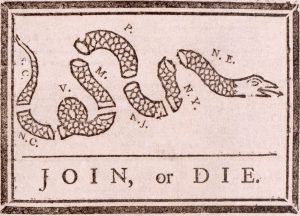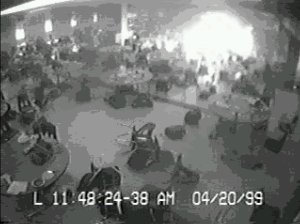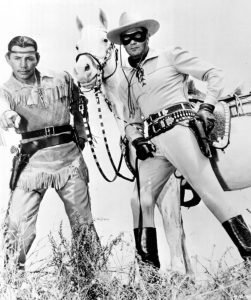2.2 Mass Media and Its Messages
When media consumers think of media messages, they may think of televised public service announcements or political advertisements. These prominent examples provide a venue to transfer a message through a medium, whether that message pleads for fire safety measures or expresses a political position. But what about more abstract political advertisements that show the logo of a candidate and a few simple words? Media messages can range from overt statements to vague expressions of cultural values.
Disagreements over the content of media messages certainly exist. Consider the common allegations of political bias against various news organizations. Accusations of subliminal messaging or agenda-driven content have long plagued the media, but as media saturation increases, the debate over media messages also intensifies. This dialogue deserves an opportunity; after all, mass media have long served as tools of persuasion. Many modern persuasive techniques stem from the use of media as a propaganda tool. This section outlines the role of propaganda and persuasion in the mass media, as well as the media’s influence.
Propaganda and Persuasion
Encyclopedia Britannica defines propaganda simply as the “manipulation of information to influence public opinion (Britannica Concise Encyclopedia).” This definition is well-suited for this discussion because the study and use of propaganda have had a profound influence on the role of persuasion in modern mass media. In his book The Creation of the Media, Paul Starr argues that the United States, as a liberal democracy, has favored employing an independent press as a public guardian, thus putting the media in an inherently political position (Starr, 2004). The United States—in contrast to other nations where the media face government restrictions—has encouraged an independent commercial press, thereby giving the public the power of propaganda and persuasion (Starr, 2004).

Like any form of communication, propaganda is neither inherently good nor inherently bad. Whether propaganda has a positive or negative effect on society and culture depends on the motivations behind its use. People promoting movements as wide-ranging as Christianity, the American Revolution, and the communist revolutions of the 20th century have all used propaganda to disseminate their messages (Jowett & O’Donnell, 2006). Newspapers and pamphlets that glorified the sacrifices at Lexington and Concord and trumpeted the victories of George Washington’s army greatly aided the American Revolution. For example, Benjamin Franklin’s famous illustration of a severed snake with the caption “Join or Die” serves as an early testament to the power and use of print propaganda (Jowett & O’Donnell, 2006).
Chapter 4, “Newspapers,” will outline how the penny press made newspapers accessible to a mass audience and became a force for social cohesion during the 1830s (Jowett & O’Donnell, 2006). Magazines adopted a similar format in the 19th century, and the political and social power of print media rose. In an infamous example of the new power of print media, some newspapers encouraged the Spanish-American War of 1898 by fabricating stories of Spanish atrocities and sabotage (Jowett & O’Donnell, 2006). For example, after the USS Maine sank off the coast of Havana, Cuba, some newspapers blamed the Spanish—even though no evidence existed—fueling the public’s desire for war with Spain.
The present-day pejorative connotation of propaganda stems from the extensive use of mass media by World War I–era governments to mobilize the citizenry of many countries to go to war. Some media outlets characterized the war as a global struggle between Anglo-Saxon civilization and Prussian barbarism. Although some of those fighting the war had a limited understanding of the political motivations behind it, wartime propaganda effectively convinced them to enlist (Miller, 2005). As discussed in Chapter 12, “Advertising and Public Relations”, World War I legitimized the advertising profession in the minds of government and corporate leaders because its techniques helped develop several successful patriotic propaganda campaigns. Corporations quickly adapted to this development and created an advertising boom in the 1920s by using World War I propaganda techniques to sell products (Miller, 2005).
In modern society, governments, corporations, nonprofit organizations, and political campaigns utilize both traditional and new media to convey messages to the general public. The comparatively unregulated nature of U.S. media has, for better or worse, created a society in which everyone has access to tools of public persuasion.
Media and Behavior
Although the mass media send messages created specifically for public consumption, they also convey messages that fall outside the scope of propaganda or persuasion. Some argue that these messages influence the behavior of young people, especially (Beatty, 2006). Violent, sexual, and compulsive behaviors have been linked to media consumption and thus raise important questions about the effects of media on culture.
Violence and the Media
On April 20, 1999, students Eric Harris and Dylan Klebold entered their Denver-area high school, Columbine High School, armed with semiautomatic weapons and explosives. Over the next few hours, the pair killed 12 classmates and one faculty member before committing suicide (Lamb, 2008). The tragedy and its aftermath captured national attention, and in the weeks following the Columbine High School shootings, politicians and pundits worked to assign blame. Their targets ranged from the makers of the first-person shooter video game Doom to the Hollywood studios responsible for The Matrix (Brook, 1999).
However, in the decades since the massacre, research has revealed that the perpetrators wanted to attempt a terrorist bombing rather than a first-person shooter-style rampage (Toppo, 1999). But did violent video games so desensitize the two teenagers to violence that they could contemplate such a plan? Did movies that glorify violent solutions create a culture that would encourage people to consider such methods? Because modern culture has immersed itself in media messages, the issue has become a particularly complex one, and it remains difficult to understand the types of effects that violent media produce.

Many studies have verified certain connections between violent video games and violent behavior in young people, with the most recent research focused on the adverse effects of violent media consumption. For example, large-scale studies called meta-analyses have consistently found a positive correlation between exposure to violent media and aggressive behavior, particularly in children and adolescents (Anderson et al., 2010). Longitudinal studies have demonstrated that exposure to violent media in early childhood can predict aggressive and antisocial behavior later in life (Robertson, McAnally, and Hancox, 2013 ). Some researchers have used neuroimaging to reveal that exposure to violent media can activate regions in the brain associated with aggression and desensitize individuals to violence (Anderson and Prot, 2011).
Other studies demonstrate the complexity of studying this subject. Christopher Ferguson’s meta-analysis found the influence of video games on increased aggression to be minimal (2015), while Dr. Simone Kühn and her colleagues found no evidence of violent video games leading to harmful effects on the brain’s structure or function (2019).
Whether violent media cause violence remains unknown, but unquestionably, these forms of media send an emotional message to which individuals respond. Not all media messages come in the form of overt statements; they can also use emotions, such as fear, love, happiness, and depression. These emotional reactions partially account for the intense power of media in our culture.
Sex and the Media
In many types of media, sexual content—and its strong emotional message—proliferates. A study by researchers at the University of North Carolina entitled “Sexy Media Matter: Exposure to Sexual Content in Music, Movies, Television, and Magazines Predicts Black and White Adolescents’ Sexual Behavior” found that young people with heavy exposure to sexually themed media ranging from music to movies are twice as likely to engage in early sexual behavior as young people with light exposure. Although the study does not prove a conclusive link between sexual behavior and sexually oriented media, researchers concluded that media acted as an influential source of information about sex for these youth groups (Dohney, 2006). Researcher Jane Brown thinks part of the reason children watch sexual content is related to puberty and their desire to learn about sex. While many parents are hesitant to discuss sex with their children, the media can act like a “super peer,” providing information in movies, television, music, and magazines (Dohney, 2006). Chapter 14, “Ethics of Mass Media,” will discuss the impact of sexual content in the media.
Cultural Messages and the Media
The media sends messages that reinforce cultural values. These values are most visibly manifested in celebrities and the roles they adopt. Actors such as John Wayne and Marilyn Monroe came to represent aspects of masculinity and femininity that mainstream culture adopted during the mid-20th century. Throughout the 1990s, basketball player Michael Jordan appeared in television, film, magazines, and advertising campaigns as a model of athleticism and willpower. Singers such as Bob Dylan have represented a sense of freedom and rebellion against mainstream culture.

Although many consider celebrity culture superficial and a poor reflection of a country’s values, not all celebrities work in the entertainment industry. Civil rights leaders, social reformers, and other notable public figures have come to represent significant cultural achievements and advancements through their portrayal in the media. When images of Abraham Lincoln or Susan B. Anthony appear in the press, they resonate with cultural and historical themes significantly separated from mere fame.
Celebrities can also reinforce cultural stereotypes that marginalize certain groups. Television and magazines from the mid-20th century often portrayed women in a submissive, domestic role, both reflecting and reinforcing the cultural limitations imposed on women at the time. Advertising icons developed during the early 20th century, such as Aunt Jemima and the Cream of Wheat chef, similarly reflected and reinforced a submissive, domestic servant role for African Americans. Other famous stereotypes—such as the Lone Ranger’s Native American sidekick, Tonto, or Mickey Rooney’s Mr. Yunioshi role in Breakfast at Tiffany’s—also reinforced American preconceptions about ethnic predispositions and capabilities.
Whether actual or fictional, celebrities and their assumed roles convey a range of messages about cultural values. They can promote courageous truth-telling, hide and prolong social problems, or provide a concrete example of an abstract cultural value.
New Media and Society
New media—the Internet and other digital forms of communication—have had a large effect on society. This communication and information revolution has created considerable concern about digital literacy and other issues that inevitably accompany such a profound social change. In his book on technology and communication, A Better Pencil, Dennis Baron discusses this issue:
For Plato, only speech, not writing, can produce the kind of back-and-forth—the dialogue—that’s needed to get at the truth…the text, orphaned by its author once it’s on the page, cannot defend itself against misreading…. These are strong arguments, but even in Plato’s day, they had been rendered moot by the success of the written word. Although the literacy rate in classical Greece was well below 10 percent, writing had become a vital component of the culture. People had learned to trust and use certain kinds of writing—legal texts, public inscriptions, business documents, personal letters, and even literature—and as they did so, they realized that writing, on closer examination, turned out to be neither more nor less reliable or ambiguous than the spoken word. It was just as real (Baron, 2009).
Baron makes the point that all communication revolutions have created upheavals and have changed the standards of literacy and communication. This historical perspective gives a positive interpretation to some otherwise ominous developments in communication and culture.
Information
The Internet has made an incredible amount of new information available to the general public. Both this wealth of information and the ways people process it are having an enormous effect on culture. New perceptions of information have emerged as access to it grows. Older media consumption habits required in-depth processing of data through a particular form of media. For example, consumers read, watch, or view a news report in its entirety, typically within the context of a news publication or program. Fiction appeared in book or magazine form.
Today, information is easier to access, making it more likely to be disseminated across various forms of media. An individual may read an article on a news website and then forward part of it to a friend. That person, in turn, describes it to a coworker without having seen the original context. The ready availability of information through search engines may explain how a satirical Onion tweet about a Subway 9/11 promotion was taken as fact. Increasingly, media outlets cater to this habit of searching for specific bits of information devoid of context. Information that attracts the most attention often takes precedence over more important stories. At one point on March 11, 2010, for example, The Washington Post website’s most popular story was “Maintaining a Sex Life (Kakutani, 2010).”
With numerous options to access news and political commentary, modern audiences select information silos that align with their subjective viewpoints. Some analysts have used the term “cyberbalkanization” to describe how media consumers filter information. Balkanization refers to the political fragmentation of Eastern Europe’s Balkan states following World War I, when the Ottoman Empire disintegrated into numerous ethnic and political entities. Customized news feeds enable individuals to receive only the types of news and information they want, thereby blocking out sources that report unwanted stories or perspectives. Many cultural critics have identified this type of information filtering as a key contributor to the growing political division and the subsequent decline of civic discourse. When media consumers hear only the information they want to, the common ground of public discourse that stems from general agreement on certain principles inevitably grows smaller (Kakutani, 2010).
Literacy
The growth of the Internet as the primary information source exposes the public to increased levels of text, thereby improving overall literacy. Indeed, written text provides essential benefits to the Internet experience: Web content remains overwhelmingly text-based, and successful participation in Internet culture through the usage of its tools like blogs, social media platforms, forums, or personal websites requires a degree of textual literacy that exceeds the necessary skills to engage with television, music, or movies.
Critics of Internet literacy, however, describe the majority of forum and blog posts as subliterate, arguing that the Internet has replaced the printed newspapers and books that raised literacy standards. A nuanced examination of the Internet’s impact on the way a culture processes and perceives information suggests that literacy will not simply increase or decrease, but will change qualitatively (Choney, 2010). Perhaps the standards for literacy will shift to an emphasis on simplicity and directness, for example, rather than on elaborate language use.
News
Certainly, the Internet has significantly impacted the way cultures consume news. The public expects to receive information quickly, and news outlets respond rapidly to breaking stories.
Before April 26, 2024, some media pundits had projected South Dakota Governor Kristi Noem as a strong candidate as vice president for Donald Trump’s 2024 presidential election. She catapulted her name into the headlines for all the wrong reasons when she decided to share an anecdote about killing her 14-month-old dog in a book she wrote, intending to promote the idea she would do anything “difficult, messy, and ugly” if it needed to get done (Cain, 2024). She quickly became a punchline on late-night television and subjected herself to a string of disastrous media interviews (Miller, 2024). Internet users clamored for information about the scandal; Noem’s name became one of only two politically themed searches that exceeded 200,000 queries on Google in April of that year (Amp, 2024).
The Epic Exception: When YouTube Goes Long and Wins Big

Researchers have increasingly suggested a link between humans’ decreasing attention spans and the ubiquitous usage of social media. This hypothesis posits that the constant stream of bite-sized content on platforms like TikTok and YouTube has conditioned users to prefer quick, digestible information. These platforms, in turn, have smartly capitalized on this shift by incentivizing creators to produce short-form videos, which, due to their rapid consumption and high volume, can often generate more advertising revenue than their longer-form counterparts. This feedback loop creates an environment where brevity is often rewarded, seemingly reinforcing the notion that modern audiences simply can’t sit still for extended periods.
Despite this pervasive trend towards conciseness, a fascinating counter-narrative has emerged within the digital landscape. Some intrepid content creators have defied expectations, delivering videos with run-times that shockingly exceed the length of cinematic epics like Avengers: Endgame. Yet, in a testament to the power of compelling storytelling and deep dives, these creators still manage to draw in millions of viewers and earn significant media recognition for their exceptionally thorough yet enjoyable output. This phenomenon challenges the prevailing wisdom about attention spans, suggesting that quality and depth can still captivate audiences, even in an era of rapid-fire content.
Two notable examples that have unequivocally proved quantity can indeed equal quality in the digital realm are YouTube content creators hbomberguy and Jenny Nicholson. hbomberguy’s nearly four-hour magnum opus, “Plagiarism and You(Tube),” is a meticulously researched and engaging exposé that has soared past 33 million views. Its impact was so significant that it even caught the attention of mainstream outlets like NBC News, a rare feat for a video of such length. Similarly, Jenny Nicholson captivated audiences with her sprawling recollection of a visit to a now-defunct Disney attraction in “The Spectacular Failure of the Star Wars Hotel.” This epic spanned more than four hours and garnered over 11 million views on YouTube, receiving high praise from publications like the New York Times for its detailed narrative and sharp wit. These creators excel not by sacrificing depth for brevity, but by offering a rich, immersive experience that rewards viewer investment. Their success highlights a segment of the online audience that craves comprehensive analysis and engaging narratives, pushing back against the perceived tyranny of the short-form video.
Convergence Culture
The term “convergence” can have several different meanings. In his book Convergence Culture: Where Old and New Media Collide, Henry Jenkins offers a useful definition of convergence as it applies to new media:
“By convergence, I mean the flow of content across multiple media platforms, the cooperation between multiple media industries, and the migratory behavior of media audiences who will go almost anywhere in search of the kinds of entertainment experiences they want (Jenkins, 2006).”
A self-produced video on the YouTube platform that gains enormous popularity and thus receives the attention of a news outlet provides a good example of this migration of both content and audiences. Consider this scenario: a video gains notoriety, prompting a news outlet to release a story about it, which in turn increases its popularity on YouTube. This migration works in several ways. Humorous or poignant excerpts from television or radio broadcasts are often shared on social media sites and blogs, where they gain popularity and increased exposure.
Thanks to new media, consumers now view all types of media as participatory. For example, the talent show American Idol combines an older media format—television—with modern media consumption patterns by allowing the home audience to vote for their favorite contestant. However, American Idol segments regularly appear on YouTube and other websites, where people who may never have seen the show comment on and dissect them. Phone companies report a regular increase in phone traffic following the show, presumably due to viewers calling in to cast their votes or discuss the program with friends and family. As a result, more people become exposed to the themes, principles, and culture of American Idol than the number of people who watch the show (Jenkins, 2006).
New media have encouraged greater personal participation in media as a whole. User-generated content has transformed the media landscape by providing eyewitness accounts or nuanced content often delivered by passionate fans of the topics they highlight. This has expanded the type of content and viewpoints available to the general public. As audiences become more adept at navigating and creating media (with or without AI-assisted tools), more people will likely engage with user-generated content.
When Bert Met Bin Laden: A Viral Tale of Media Migration

In 2001, high school student Dino Ignacio created a collage of Sesame Street character Bert with terrorist Osama bin Laden as part of a series for his website. Called “Bert Is Evil,” the series featured the puppet engaged in a variety of illicit activities. A Bangladesh-based publisher looking for images of bin Laden found the collage on the Internet and used it in an anti-American protest poster, presumably without knowledge of Bert’s history. This ultimately led to a CNN report on anti-American protests and public outrage over the use of Bert, making Ignacio’s original site a much-imitated cult phenomenon.
The journey of this collage from a high school student’s website to an anti-American protest poster in the Middle East, to a cable television news network, and finally back to the Internet provides a good illustration of how content migrates across media platforms in the modern era. As the college expanded across geographic and cultural boundaries, it gained visibility in both corporate and grassroots media. While most media content will not repeat this exact cycle, the possibility of such a phenomenon illustrates the new directions media can go (Jenkins, 2006).

